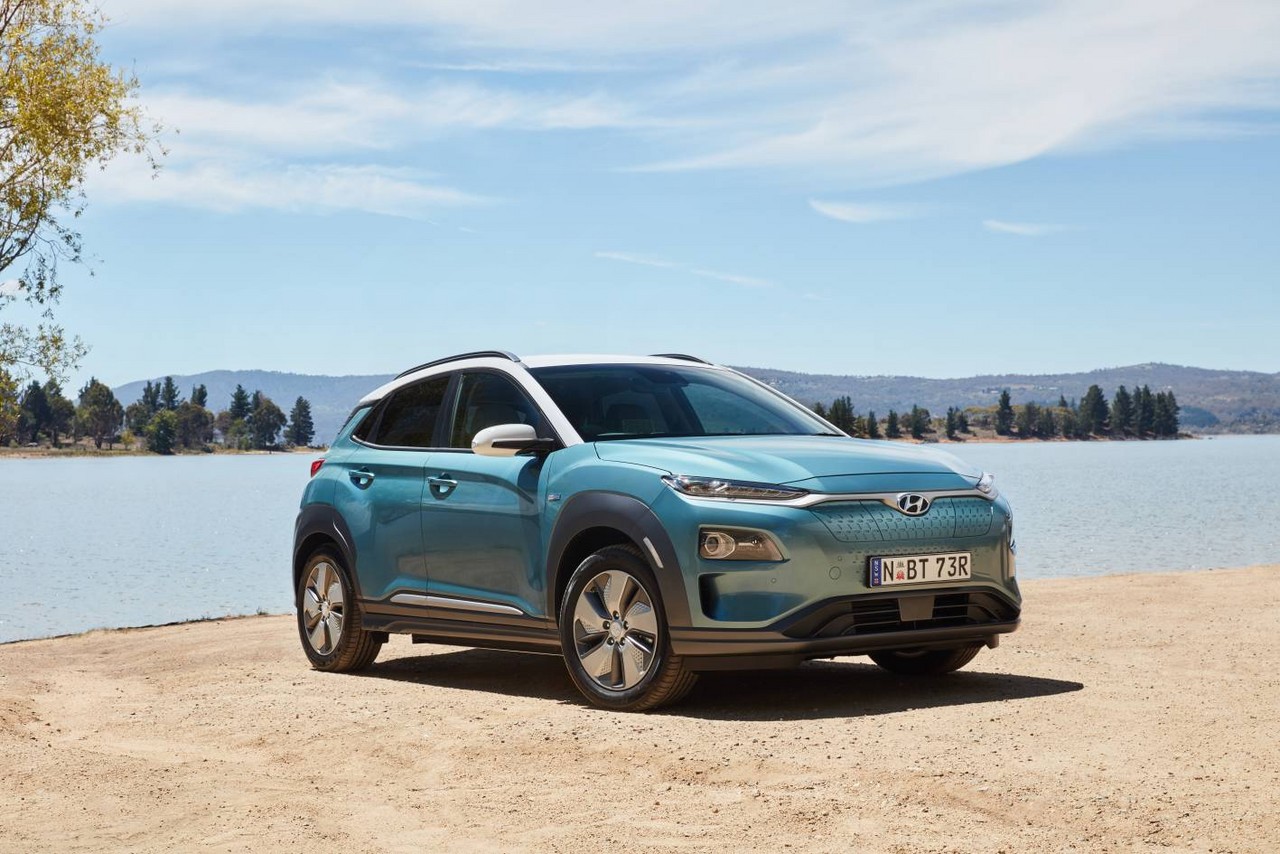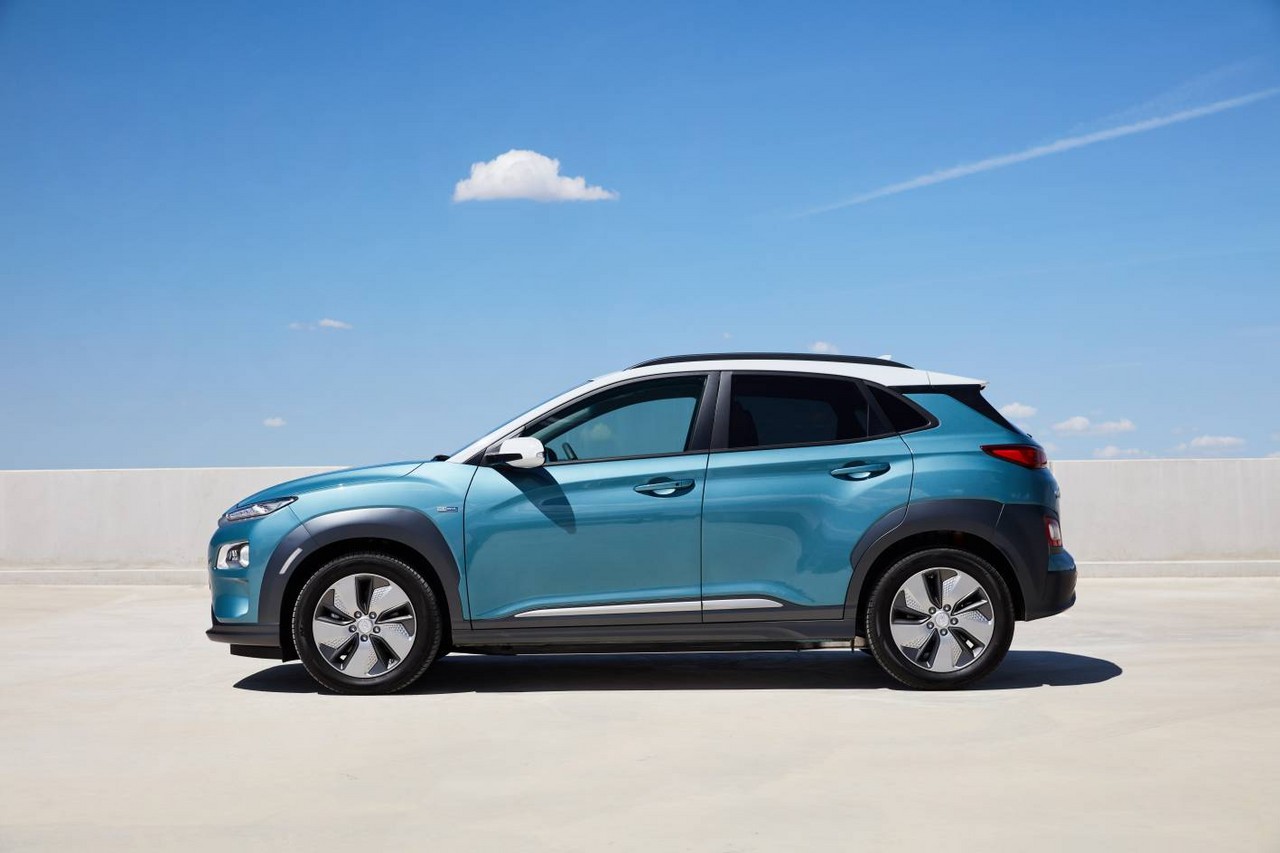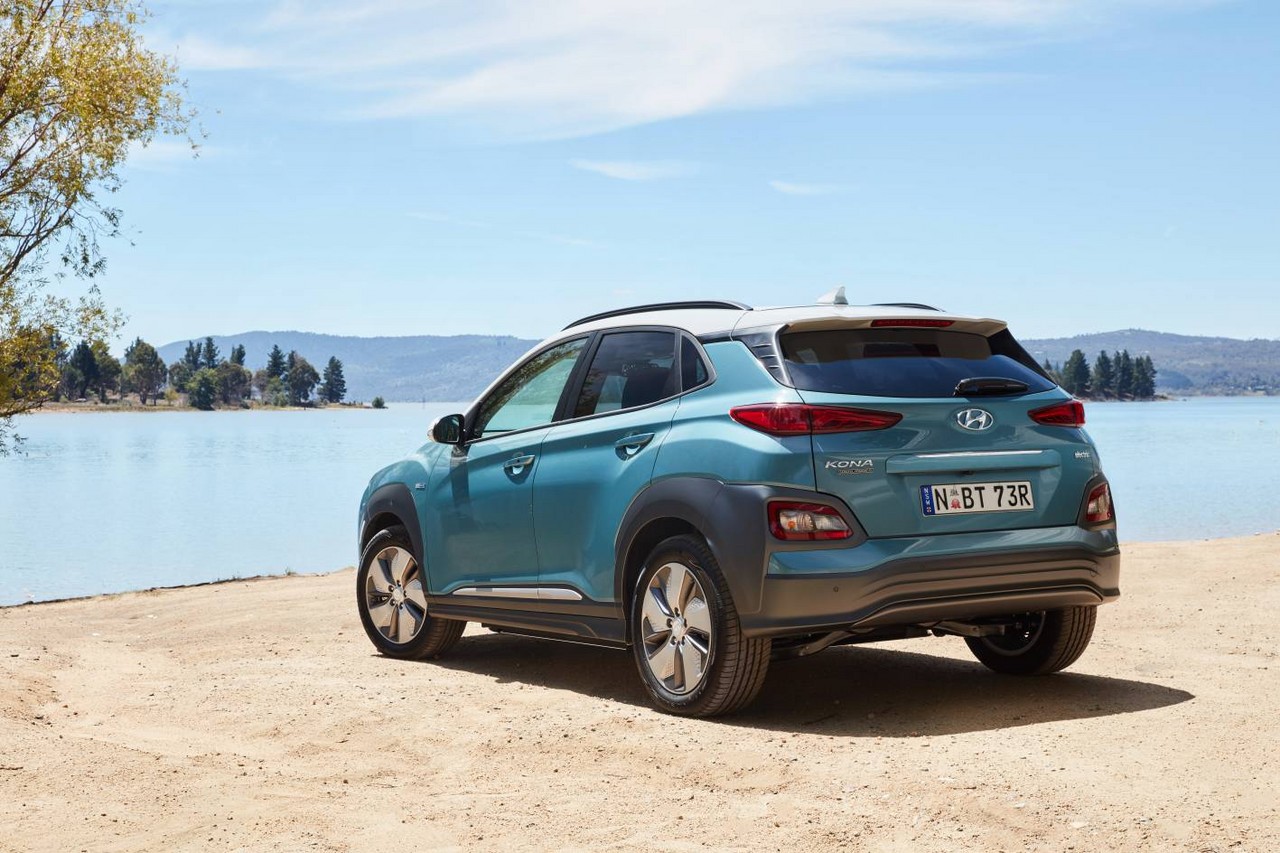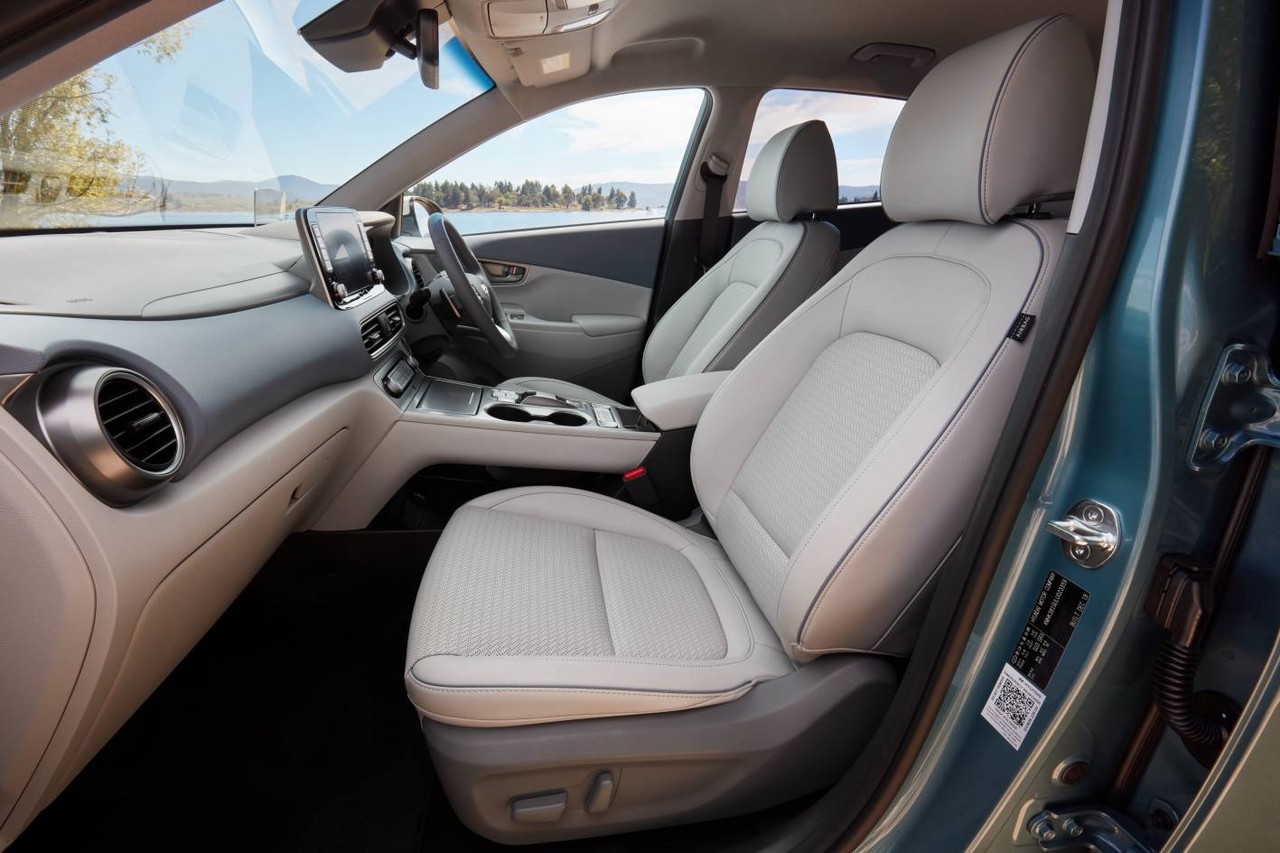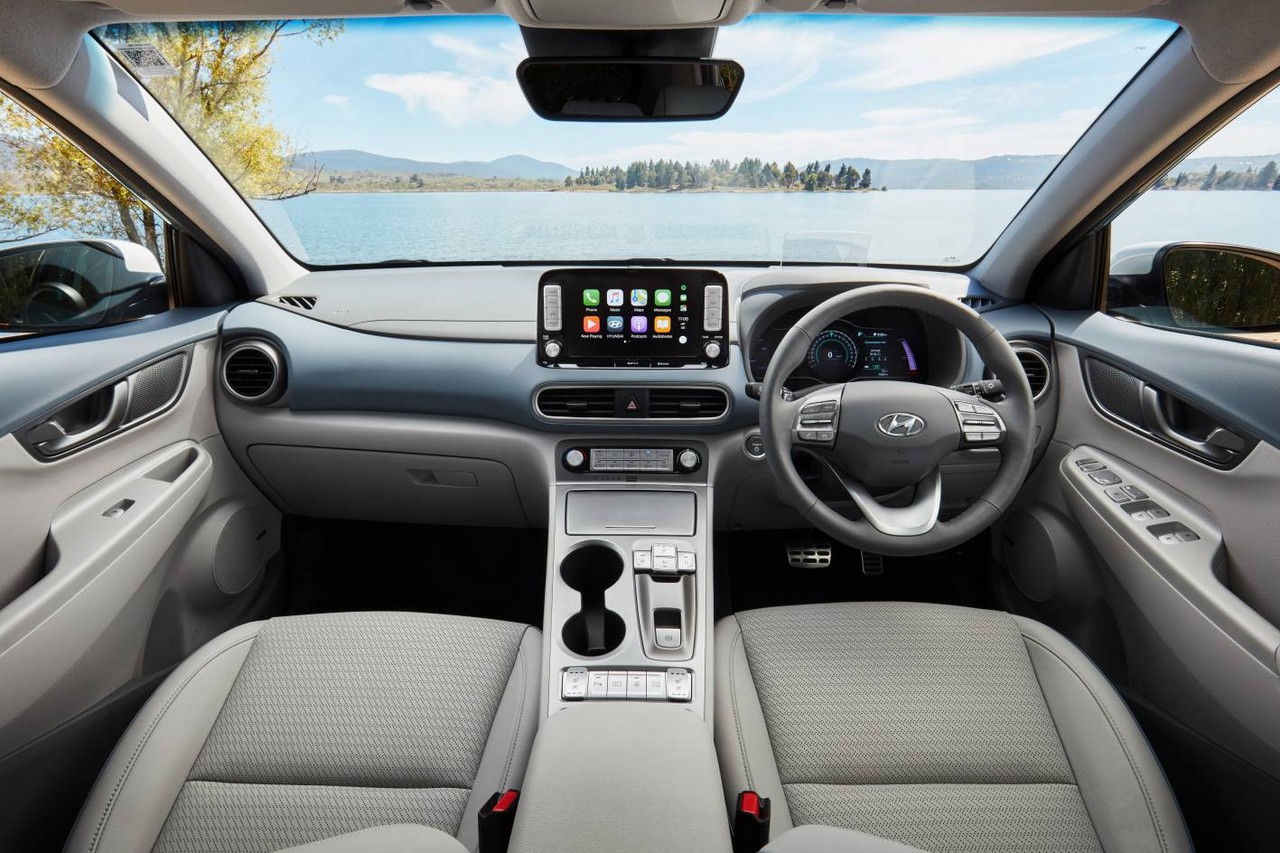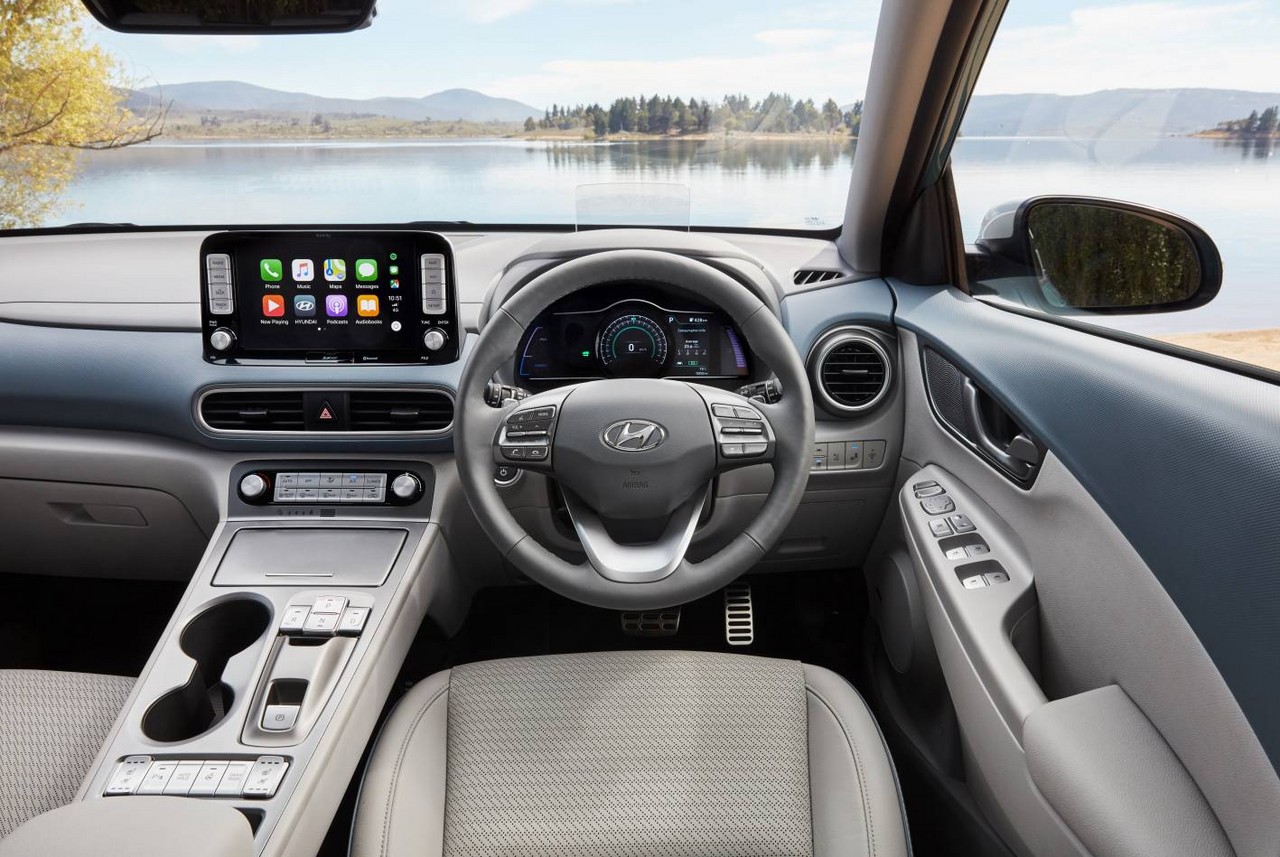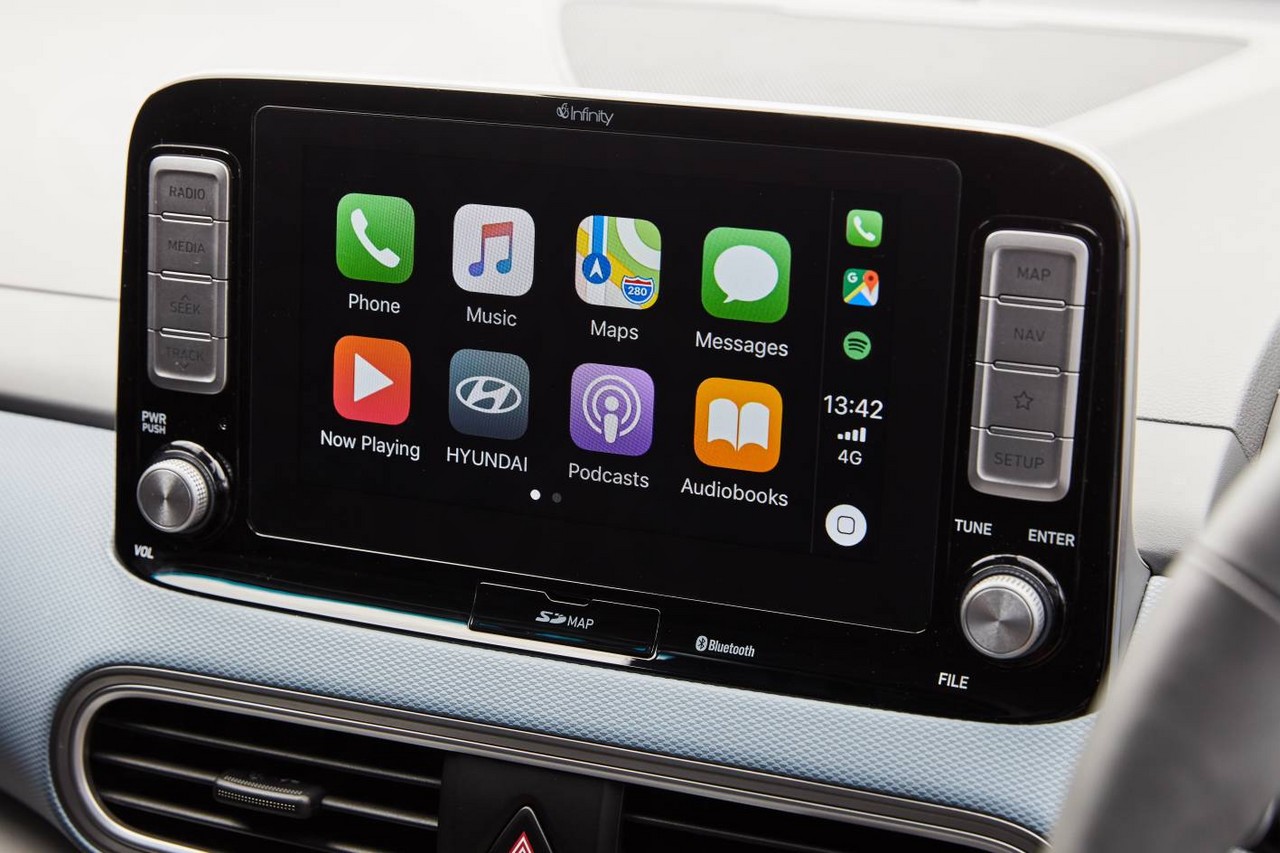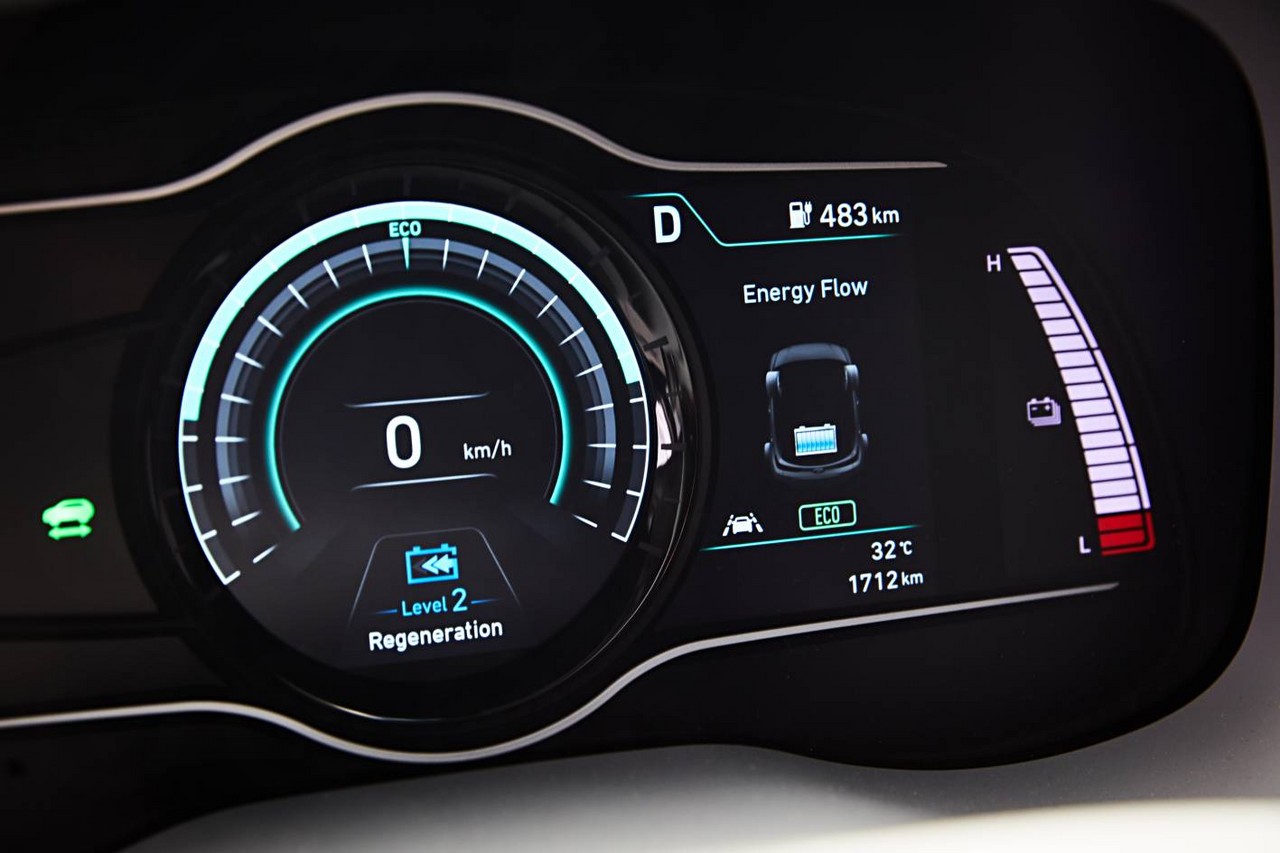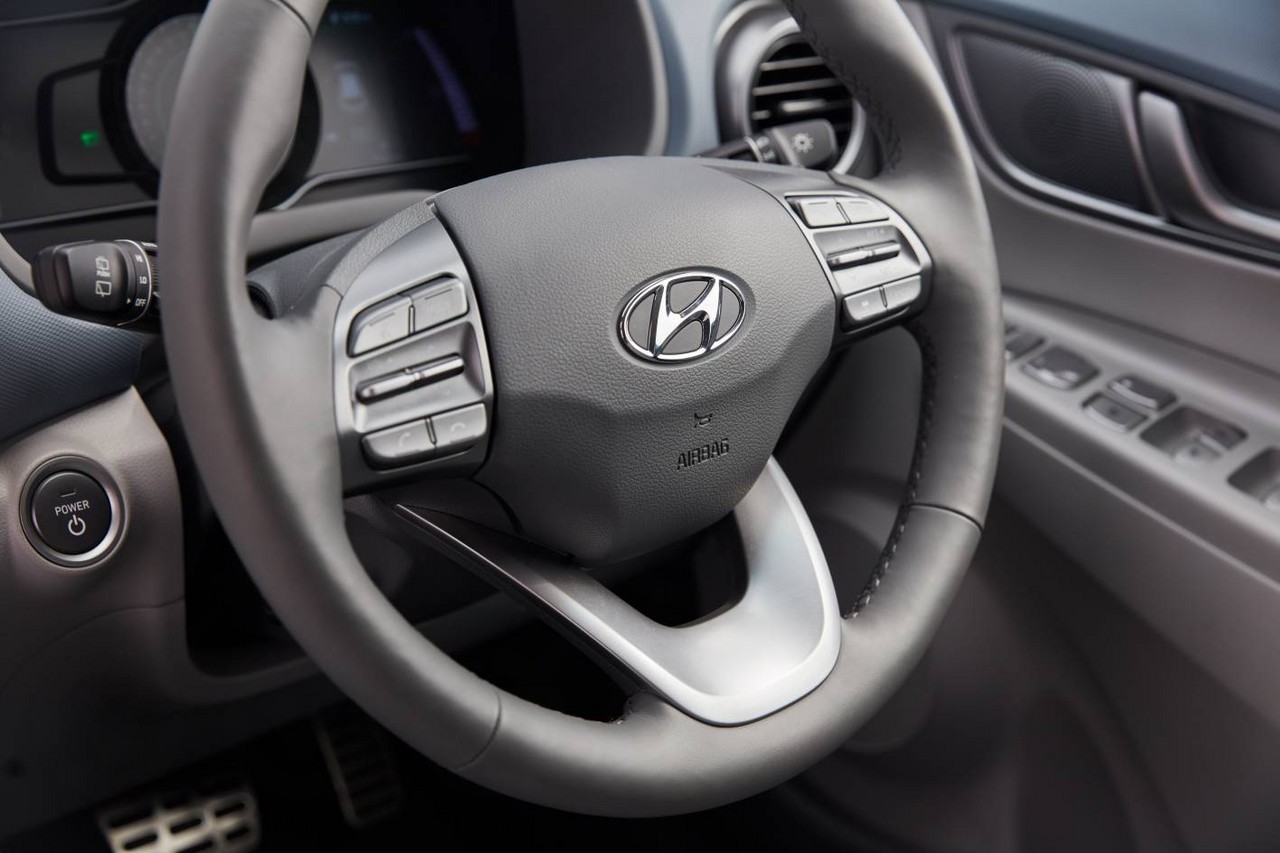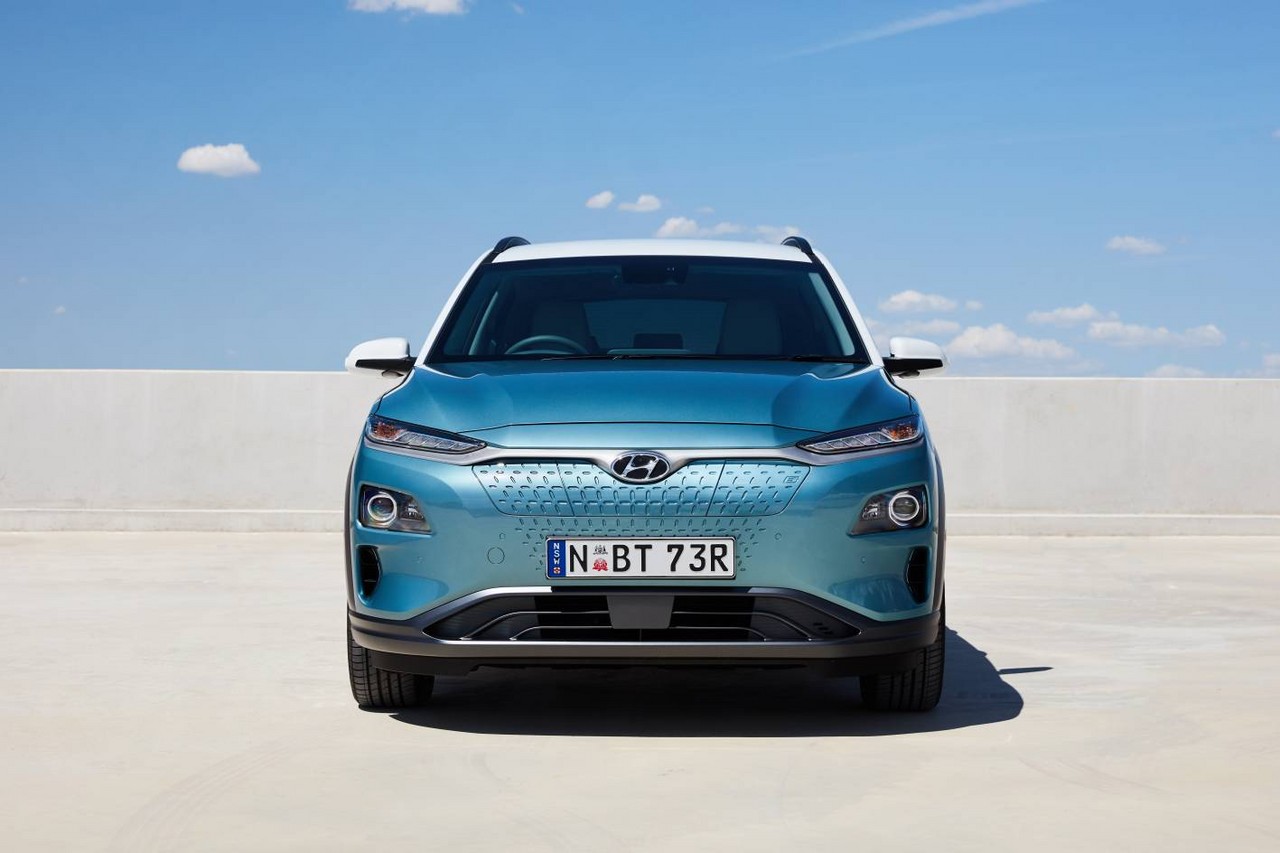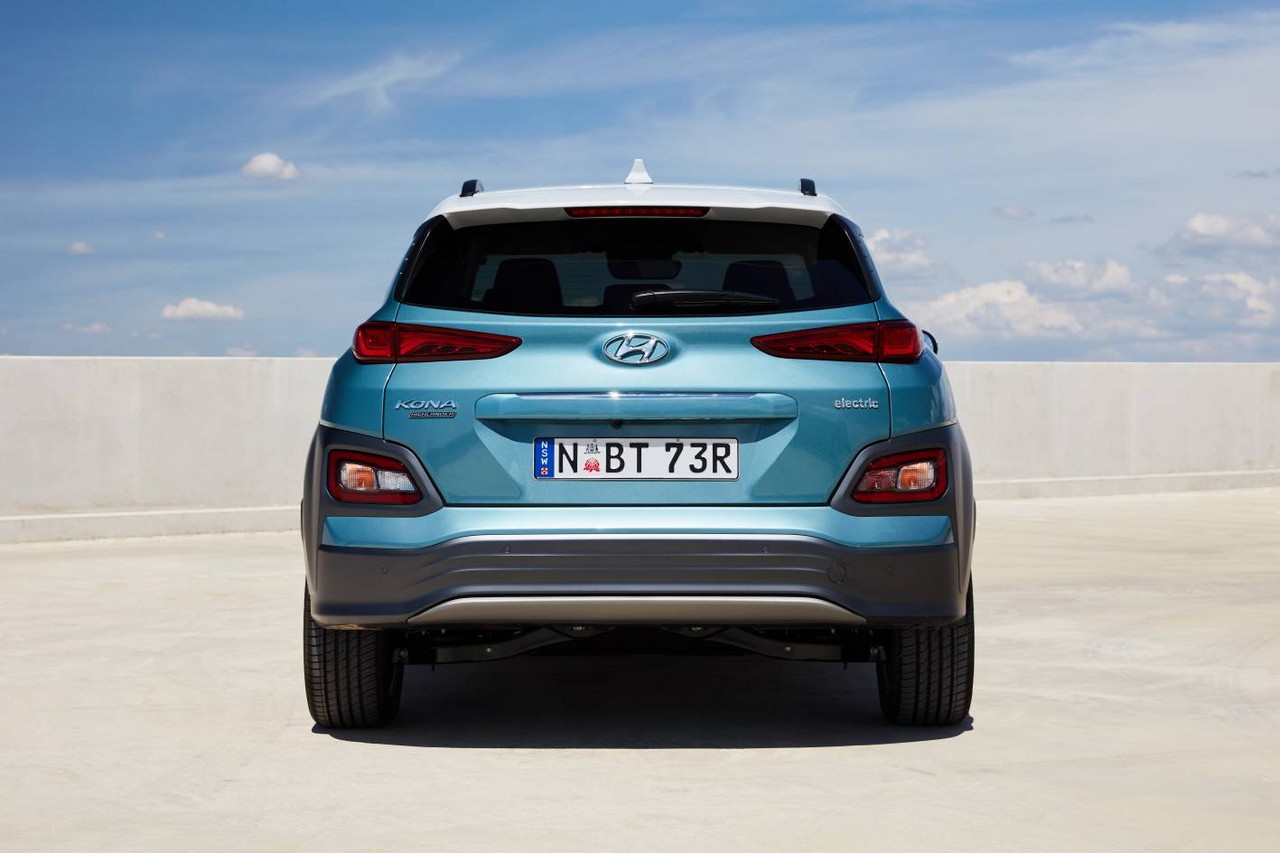
- Responsive electric motor
- Impressive 449 km driving range (WLTP standard)
- Active safety technologies fitted as standard
- Accomplished ride/handling balance
- Significant price premium to standard Hyundai Kona (circa $30,000)
- Cramped rear seats
- Tyre noise
- Cheap interior plastics
Overview
Released in Australia in March 2019, the Hyundai OS Kona Electric was a compact SUV with an electric drivetrain. Manufactured in Ulsan, South Korea, the front wheels of the Hyundai Kona Electric were powered by a permanent magnet synchronous motor that drew power from a 356 volt, 64.0 kWh lithium-ion polymer battery. For its battery, Hyundai provided an eight year or 160,000 kilometre warranty (whichever came first). For Australia, the Kona Electric was offered in Elite and Highlander editions which had list prices (excluding on-road costs) of $59,990 and $64,490 upon their release.
The Hyundai Kona Electric two on-board chargers:
- An AC charger with a capacity of 7.2 kW. Using a 240 volt power, the Kona Electric’s battery could be charged in approximately 9 hours and 35 minutes; and,
- A DC fast charger which had a peak capacity charging capacity of 100 kW and an output of 230 volts and 10 amperes. Using 50 kW charging, the battery could be charged up to 80 per cent of its capacity in approximately 75 minutes. Using 100 kW charging, the battery could be charged up to 80 per cent of its capacity in approximately 54 minutes.
Under the NEDC and ADR 81/02 standard, the Hyundai Kona Electric had a driving range of 557 km. Under the WLTP standard, however, the Kona Electric had a ‘real world range’ of 449 km. Furthermore, the Hyundai Kona Electric could accelerate from rest to 100 km/h in 7.6 seconds and had a top speed of 167 km/h.
| Motor | Trans. | Peak power | Peak torque |
|---|---|---|---|
| Permanent magnet synchronous motor | Single speed reduction gear (7.98:1) | 150 kW | 395 Nm |
Body and dimensions
The Hyundai OS Kona Electric and Hyundai OS Kona were underpinned by a platform that was developed for compact SUVs and shared with the Kia Stonic (not available in Australia). Furthermore, AustralianCar.Reviews understands that the platform was related to that which underpinned the Hyundai PD i30 . According to Hyundai, 51.8 per cent of the body consisted of advanced high strength steel (AHSS) and 114.5 metres of structural adhesive was used to bond components.
Compared to the OS Kona , the OS Kona Electric was 15 mm longer (at 4180 mm) and 5 mm taller (1570 mm, including the standard roof rails), though width (1800 mm) and wheelbase length (2600 mm) were unchanged. Beyond this,
- Kerb weights for the Hyundai Kona Electric ranged from 1685 kg to 1743 kg, an increase of around 350 kg relative to the Hyundai OS Kona 2.0 MPI; and,
- Luggage capacity was 332 litres (VDA method), 29 litres less than the standard OS Kona.
Suspension and steering
The Hyundai Kona Electric had MacPherson strut front suspension (including alloy front lower control arms rather than the steel arms of the standard OS Kona) and multi-link rear suspension. Hyundai Australia’s engineering division developed a unique suspension tune for the Kona Electric, evaluating 15 different front damper settings and 22 different rear damper settings.
The Hyundai Kona Electric had rack-and-pinion steering with ‘Column-mounted Motor Driven Power Steering’ (Hyundai’s C-MDPS). The steering wheel required 2.5 turns from lock to lock, while the Kona Electric had a turning circle of 10.6 metres (kerb to kerb).
Safety equipment
Standard safety equipment for the Hyundai Kona Electric included dual front airbags, front seat-mounted side airbags, full-length curtain airbags, ABS, electronic brake force distribution, brake assist, electronic stability control, traction control and front seatbelts with pre-tensioners and load limiters.
The Hyundai Kona Electric were also further equipped with the following active safety technologies –
- Forward Collision Warning (FCW): operating at speeds from 8 km/h to 65 km/h for pedestrian detection and up to 170 km/h for vehicle detection, FCW used front radar and camera sensors to detect frontal collision risks. If there was a risk of a frontal collision, the driver would be alerted by visual and acoustic warnings;
- Forward Collision-Avoidance Assist (FCA): if the collision risk persisted after the Forward Collision Warning (FCW), the braking system would be prepared so that it would respond faster when the brakes were applied. When a collision was assessed to be unavoidable, maximum braking force would be applied (i.e. autonomous emergency braking or AEB) to reduce vehicle speed and the severity of the collision;
- Smart Cruise Control (SCC): used the front radar sensor to detect the speed and distance of vehicles ahead of the Kona Electric. SCC would then maintain a safe distance to that vehicle, up to the cruising speed – between 30 km/h and 180 km/h – set by the driver. If the vehicle ahead came to a stop, SCC would slow the vehicle to 10 km/h before prompting the driver to take control. The Smart Cruise Control system for the Kona Electric also had a ‘stop & go’ function. In stop/start traffic, the stop & go function could bring the vehicle to rest and, if stationary for less than three seconds, accelerate the Kona Electric to its original cruising speed while maintaining a safe distance to the vehicle ahead;
- Lane Keeping Assist – Line (LKA-L): operating at speeds above 60 km/h, LKA-L had three modes –
- Lane Departure Warning (LDW) mode: used the windscreen-mounted camera to detect lane markings and monitor the vehicle’s position in the lane. If the vehicle departed from its lane without the indicators having been activated, audible and visual warnings would be issued;
- Standard LKA mode: provided steering intervention as the vehicle was about to leave its lane; and,
- Active LKA mode: provided earlier steering intervention to assist the vehicle staying in the centre of its lane;
- Driver Attention Warning (DAW): operating at speeds above 60 km/h, DAW monitored steering angle, steering torque and the vehicle’s position within its lane to detect inattentive or fatigued driving. If detected, the driver was alerted via an audible tone and a message that suggested they take a break;
- Blind-Spot Collision Warning (BCW): operating at speeds above 30 km/h, BCW used radar sensors to monitor the rear corners of the Hyundai Kona Electric and, if another vehicle was detected, a visual alert would appear in the relevant exterior mirror. If the driver then activated the indicators, an audible signal would be emitted; and,
- Rear Cross-Traffic Collision Warning (RCCW): using the rear radar sensors to scan a 180-degree area behind the vehicle, RCCW operated when the Kona Electric was reversing to detect approaching traffic that may cross the driver’s path. If detected, the driver would receive visual and audible warnings.
Euro NCAP testing
While the Hyundai Kona Electric has not been tested, the 2017 Hyundai OS Kona received a five star safety rating which in Euro NCAP testing which included an 87 per cent adult occupant protection rating, an 85 per cent child occupant protection rating and a 60 per cent ‘safety assist’ rating based on the Speed Assistance and Lane Assist systems being fitted as standard (though this was not the case for Australian-delivered vehicles).
In the frontal offset test, protection of both front occupants was generally rated as good, though protection of the driver’s lower legs was rated as adequate (i.e. a slight risk of serious injury). While maximum points were awarded in the side impact test, protection of the driver’s chest in the more severe pole test was rated as adequate.
Under ANCAP’s rating system , the Hyundai Kona received a five star safety rating with an overall score of 35.07 out of 37.
Wheels, tyres and brakes
The Hyundai Kona Electric had 17 x 7.0J alloy wheels with 215/55 R17 94V tyres. Rather than a spare wheel, the Kona Electric was supplied with a tyre repair kit.
The Hyundai Kona Electric had 305 mm by 25 mm ventilated front brake discs and 300 mm by 10 mm solid rear discs.
Features: Hyundai Kona Electric Elite
The infotainment system for the Hyundai Kona Electric included Infinity audio system with eight speakers (including subwoofer) and an external amplifier, digital radio tuner (DAB+), an eight-inch touchscreen, satellite navigation with SUNA live traffic updates, Bluetooth mobile phone connectivity and audio streaming, 3.5 mm auxiliary and USB audio inputs, and Apple CarPlay and Android Auto smartphone integration.
Standard features for the Hyundai Kona Electric Elite included leather seat trim, climate control air conditioning, projector beam headlights, LED daytime running lights and positioning lights, rear parking sensors, a rear view camera with dynamic guidelines, leather steering wheel trim, 60:40 split and folding rear seats, remote central locking, power adjustable door mirrors with heating and auto-folding functions, power windows, a height and reach adjustable steering column, a height adjustable driver’s seat, a 12 volt power outlet, a USB power outlet, Hyundai’s ‘Supervision’ instrument cluster (included a seven-inch LCD and digital speedometer), tyre pressure monitoring, rear privacy glass, illuminated vanity mirrors, roof rails, an alarm and immobiliser.
The Hyundai Kona Electric Elite was also equipped with –
- High Beam Assist (HBA): operating at speeds above 40 km/h in its ‘Auto’ mode, HBA used a windscreen-mounted camera to detect oncoming vehicles and vehicles in the same lane. If detected, HBA would switch to low-beam headlights to avoid dazzling other drivers. When vehicles were no longer detected, the system would revert to high beam headlights for greater visibility; and,
- Smart Power Tailgate: would automatically unlock when the Smart Key was detected in its proximity. The tailgate could also be opened or closed by pressing the Smart Key button, or by pressing the buttons on the tailgate.
Features: Hyundai Kona Electric Highlander
Compared to the Hyundai Kona Electric Elite, the Kona Electric Highlander was further equipped with ventilated and heated front seats, a ten-way power adjustable driver’s seat, an eight-way power adjustable front passenger seat, LED headlights, LED rear combination lights, a head-up display (HUD), front parking sensors, a heated steering wheel, wireless charging pad (Qi standard), an electrochromatic rear view mirror, cloth headlining and a glass sunroof (tilt and slide panel). As a no-cost option, however, the sunroof could be omitted for a two-tone roof.
Visually, the Kona Electric Highlander could be identified by its chrome tailgate garnish.
Brochure and specifications
- Brochure: Hyundai OS Kona Electric (March 2019)
- Specifications: Hyundai OS Kona Electric (March 2019)
